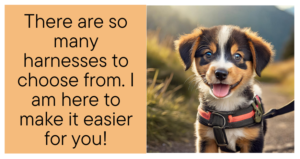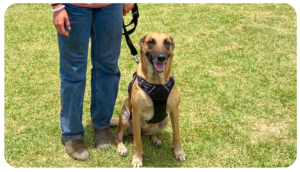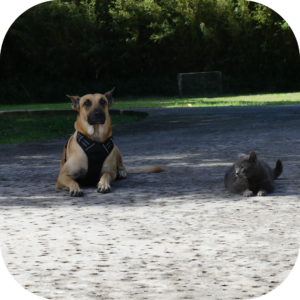 You want your dog to be comfortable, safe, and set up for success, right? Then choosing the right dog harness is an important step. But with so many options on the market, how do you know which one to choose? I’ve got you covered!
You want your dog to be comfortable, safe, and set up for success, right? Then choosing the right dog harness is an important step. But with so many options on the market, how do you know which one to choose? I’ve got you covered!
Understanding Dog Harnesses
Dog harnesses come in all shapes and sizes, just like our four-legged friends. Some look like tactical vests, others like simple straps. But there’s more to them than meets the eye. Each design serves a unique purpose, and it’s important to pick one that fits your dog’s needs.
Types of Harnesses
Just when you thought you’d seen them all, there’s another new fad in the harness scene. I’ve got your back (or should I say, your dog’s chest?) with an exploration of the most common types:
- Back-Clip Harnesses: The leash clips on the dog’s back and are great for small, gentle breeds. Think dachshunds, pugs, and other low-impact pullers.
- Front-Clip Harnesses: Perfect for training, these harnesses have the leash clip in front — ideal for dogs who pull. They redirect the dog towards you, discouraging the behavior.
- Dual-Clip Harnesses: These hybrids allow you to choose between a front and back clip, offering the versatility your walks need, especially if you have a pull-me, no-push-you kinda pup.
Spoiler alert: this is my favorite style.
…and many more.
Sizing and Fit Matters
It’s time to bust out your measuring tape! You want your pup’s harness to fit just right. The wrong size harness could lead to chafing, rubbing, and even damage your dog’s sensitive skin.
Be sure to accurately take your pup’s measurements before pressing “order” on his harness.
Factors to Consider in Your Harness Hunt
Before you head to the virtual or brick-and-mortar pet store, I recommend being mindful of a few factors:
Your Dog’s Demeanor
Is your pup a puller, a skip-to-my-Lou-er, or a casual stroller? A harness should match her manner. If you want to learn more about my leash training method, click here!
Comfort is Key
 You probably wouldn’t wear sandals on a ten-mile hike, right? The same consideration should be given to your dog’s comfort!
You probably wouldn’t wear sandals on a ten-mile hike, right? The same consideration should be given to your dog’s comfort!
Your pup’s harness might be his most-worn item, so comfort features like padding and even mesh constructions should be high on your list.
Safety Checkpoint
From reflective stitching for nighttime strolls to handle-equipped harnesses for a sudden need for control, I want you to walk with peace of mind.
Durability
Everyone wants their items to last. And a high-quality harness is worth investing in!
I’ll share more details about which harness I recommend at the end of this article. But for now, I will say it is both durable and affordable! It has lasted my family for years.
Fitting and Functionality
A harness is more than a piece of doggy fashion. It’s a tool, a connector, and a safety device. Like all tools, it must be used correctly to be effective. With these pro tips, the fit and use of your dog’s harness will be impeccable:
Snug, Not Tight
A harness should be snug to the body without constricting or causing discomfort.
Buckle or Buckle-less: Making The Choice
The world is divided into buckle fans and buckle-less enthusiasts, but when it comes to harnesses, function over fashion is the golden rule.

When it comes down to picking between buckle and buckle-less harnesses, think of your daily adventures with your furry friend. Buckle harnesses offer that satisfying click that assures you it’s securely fastened, great for those energetic pups who love darting after squirrels.
On the flip side, buckle-less harnesses slide on with ease, perfect for smooth, hassle-free mornings. Neither is superior to the other—it’s all about what makes your and your dog’s life easier, and, of course, safer.
My personal tip? Try both styles if you can. Seeing your dog’s reaction to each type can be a little experiment that leads you to your perfect match.
Which Harness I Use
I’ve used this harness for years. It’s affordable, high quality, and my dog is very comfortable wearing it.
It also has a front clip, which is one of the best tools for leash training.
If your dog pulls when the leash is attached to the front clip, the harness will cause your dog to turn around. Your pup will quickly learn that not pulling means the walk keeps moving forward!
Disclaimer: As an Amazon Associate I earn from qualifying purchases
Finding the perfect harness for your dog can feel like a mini adventure, packed with trials, errors, and happy discoveries. But with these tips, you’re now better equipped to make the right choice for you and your pup.
And remember, the best harness is one that your dog loves as much as you do. Here’s to many more joyful walks and adventures with your pup by your side!
Tom Mitchell
The 1 Minute Dog Trainer






